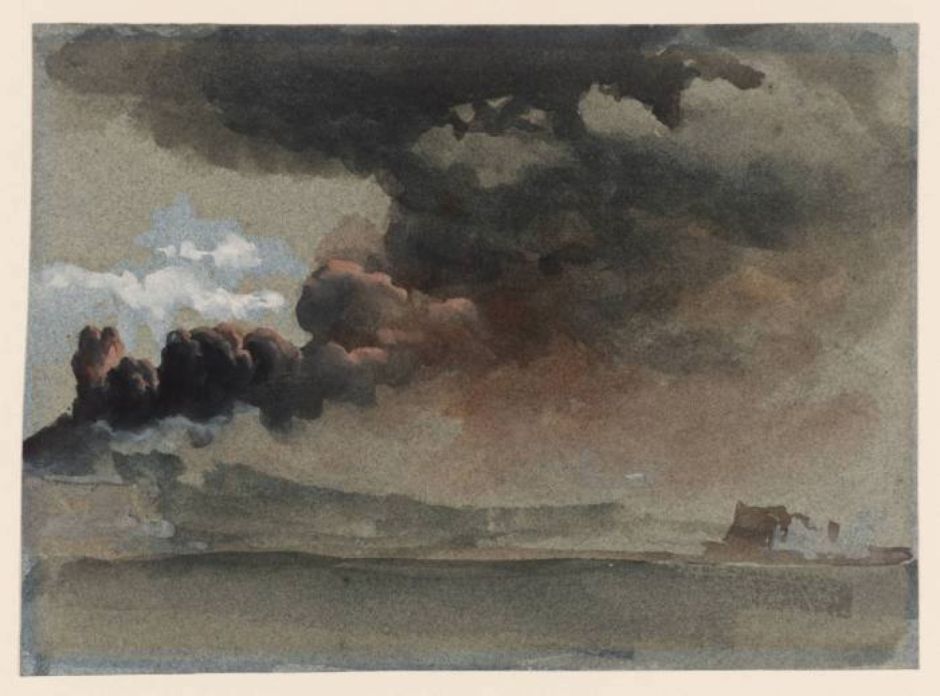Many mountains are also active volcanos. While some may be quiescent for centuries and become tourist attractions, others erupt so violently they kill anyone within several miles of their peak. Land volcanos mostly occur in long chains along the zones where earth’s tectonic plates are converging, which often coincide with mountain ranges like those of the western side of the Americas, and on the opposite side of the Ring of Fire around the Pacific Ocean.
One of the most famous images of a wave is among a collection of woodblock prints showing Mount Fuji in Japan.

Hokusai’s Great Wave off Kanagawa (Edo, 1830-32) first appeared in the collection Thirty-six Views of Mount Fuji, and proved popular not only in its home market, but also in Europe, when it arrived there more than twenty years later. Mount Fuji reaches 3,776 metres (12,389 feet) elevation, and last erupted in 1707-08. The demanding walk to its summit was accomplished by the first foreigner in 1860, when Sir Rutherford Alcock reached it in eight hours, and returned in just three hours.

Following his expedition to Ecuador, Frederic Edwin Church turned the hundreds of sketches and drawings he had made of the volcano Cotopaxi into larger finished paintings. This is an active volcano to the south of the city of Quito, and rises to a height of almost six thousand metres (nearly twenty thousand feet). Its summit is a huge crater, on top of one of the few glaciers on an equatorial mountain. Just over twenty years later, its entire ice cap was melted by the flows from one of its most violent recorded eruptions. Its summit wasn’t reached until 1873, and it’s currently in the midst of an eruption that started in October 2022.

Some of the most forceful and destructive volcanic explosions have taken place in those on and around the island of Java. In about 1876 the great botanical artist Marianne North visited and painted The Volcanoes of Merapi and Merbaboe, Java, from the Top of Boro Bodoer. Situated in central Java, Mount Merapi attains an elevation of 2,910 metres (9,550 feet), and is the most active volcano in Indonesia. Its eruption in 2010 killed over three hundred and fifty people. Mount Merbabu is slightly higher at 3,145 metres (10,318 feet) but is currently dormant. Its last moderate eruption occurred in 1797, and reaching its summit is a popular if arduous walk taking 8-10 hours.
Anyone over the age of fifty should remember well the major eruption of Mount St. Helens in 1980.

Childe Hassam’s plein air watercolour of the distant peak of Mount St. Helens in Washington State shows this active volcano that was originally just below 3,000 metres (10,000 feet) in elevation. Following that eruption in 1980, which killed fifty-seven people, that was reduced to 2,549 metres (8,363 feet). In contrast, Mount Adams is only potentially active, and hasn’t erupted in over a thousand years. Its summit at 3,743 metres (12,281 feet) was first reached in 1854, but its more challenging east face wasn’t climbed successfully until 1921.
By far the most painted active volcano is Mount Vesuvius, at the south-eastern end of the Gulf of Naples, on the west coast of Italy. Although it only reaches 1,281 metres (4,203 feet) elevation, it does so from sea level. Being situated in the midst of the Mediterranean civilisations, its history is well recorded even from before its most famous eruption in 79 CE, when it engulfed and destroyed Pompeii and three other major Roman towns. Although Vesuvius hasn’t undergone an eruption since 1944, it remains active.

Pierre-Jacques Volaire was a French landscape artist, a pupil of Vernet, who moved to Rome in 1762, and on to Naples five years later. His painting of Eruption of Vesuvius on 14 May 1771 (c 1771) is one of a series he made covering eruptions from 1767 to 1782. He was also innovative in his choice of view: here he has approached the lava flows and looks west across the Bay of Naples. This brings the moon into view, providing contrasting colours.
This eruption had started on 1 May 1771, and lasted a whole month, long enough to attract other painters.

Among those, Pietro Fabris caught its spectacular lava flows, in his Lava Emerging from Mount Vesuvius at Night and Running towards Resina, 11 May 1771, seen here in a coloured etching made in 1776 after his contemporary painting.

The long eruption and lava flows of 1771 were but a precursor to an active year in 1774, which started just before the year did, and rumbled on until 1 December. Jakob Philipp Hackert shows one of the more localised events in The Eruption of Vesuvius in 1774, painted in that year or shortly afterwards.

At some stage between about 1772 and 1785, Michael Wutky saw a more vigorous Eruption of Vesuvius, although it wasn’t so large in scale to prevent him from approaching the source of lava and smoke.

Many other paintings of Vesuvius erupting were made in the artist’s studio, well after the event. One exception to this was the British landscape and marine artist Clarkson Frederick Stanfield, whose watercolour sketch of An Eruption of Mount Vesuvius 1839 must have been painted in front of the motif in early January of that year, when the volcano was active.

By the twentieth century, Vesuvius had faded from popularity in views of the Bay of Naples, and its eruptions were largely being captured in photographs. In his later years, the American landscape artist Charles Caryl Coleman lived on the nearby island of Capri. In 1906, at the start of Vesuvius’ eruption in April, he seems to have travelled to the mainland, where he painted A Shower of Ashes Upon Ottaviano (1906) in pastels.
This shows the dust- and smoke-laden air of the Naples suburb Ottaviano at ten o’clock in the morning. Although Ottaviano was spared anything worse than dust and smoke in 1906, it was badly damaged during the volcano’s last substantial eruption in 1944.

